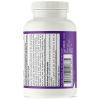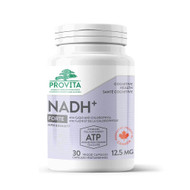Description
AOR BenaGene 30 Veg Capsules:
Contains antioxidants for the maintenance of good health. Key to a Long Healthy Life. Stimulates over 350 anti-aging genes. Shown to increase health and lifespan in animals. May help reduce blood glucose levels.
BenaGene contains the first thermally stabilized oxaloacetate, a key compound in the body’s energy production cycle. benaGene™ provides antioxidants for the maintenance of good health.
BenaGene™ is stabilized oxaloacetic acid, the world's first novel and natural Krebs cycle intermediate compound that is specifically formulated to be highly stable and bioavailable so that a one-a-day dosage is all that is required. BenaGene offers the potential of longevity and vitality and is exclusively available in Canada from AOR.
Caloric restriction is the only method proven to extend human lifespan and health span. BenaGene is a novel caloric restriction mimetic (CR mimetic), mimicking up to 98% of the changes in the genetic expression of over 350 genes in a similar fashion to caloric restriction. While human trials on BenaGene™’s effects on life extension have not been conducted for obvious reasons, human clinical trials have confirmed both reduction in glucose levels and an improved uptake of glucose without negative side effects. BenaGene™ appears to down-regulate pathways that create and store fat. Mitochondrial and cellular DNA damage is also thought to exacerbate aging, and BenaGene™ both protects and repairs DNA.
Anyone who is interested in ways to slow down the aging process will want to consider taking BeneGene™. It may also help to balance blood sugar levels in people with glucose imbalances. BenaGene™ is a perfect partner for resveratrol and other antioxidant supplementation.
What is benaGene™?
benaGene is thermally stabilized oxaloacetate, the world’s first novel and natural Krebs cycle intermediate compound that is specifically formulated to be highly stable and bioavailable so that a one-a-day dosage is all that is required, making its exciting health benefits easy to swallow.
The Key: A High NAD /NADH Ratio:
NAD (nicotinamide adenine dinucleotide) is a niacin-derived coenzyme that is present in all living cells and is critical to the production of ATP – the body’s primary source of all immediate energy. Higher NAD levels are thought to have a stimulatory effect on beneficial genes whilst a high NADH concentration is thought to inhibit beneficial genes. benaGeneTM appears to promote a high NAD /NADH ratio.
benaGene increases the conversion of NADH to NAD and also influences changes in the electrical state (Gibbs free energy) and critical signalling molecules. Oxaloacetate has also been found to prevent brain mitochondrial DNA damage in mice.
Ingredients:
| Each Capsule Contains: | |
| BenaGene (3-carboxy-3-oxopropanoic acid) | 100 mg |
| Vitamin C | 100 mg |
Non-medicinal ingredients: microcrystalline cellulose, sodium stearyl fumarate. Capsule: hypromellose.
Purity: Non GMO, Vegan, that no ingredients not listed on the label have been added to the product. Contains no wheat, gluten, nuts, peanuts, sesame seeds, sulphites, mustard, soy, dairy, eggs, fish, shellfish or any animal byproduct.
Suggested Dose: Take 1 capsule daily with food or as directed by a qualified health care practitioner.
Cautions : Do not use if pregnant or breastfeeding. Consult a health care practitioner before use if you have diabetes. Discontinue use and consult a health care practitioner if you experience symptoms of hypoglycemia including feelings of anxiety, dizziness, tremor, sweating, nausea or headache.
Main Applications: Antioxidant, Anti-aging, Glucose metabolism.
References:
- Bhattacharya, R. and R. Tulsawani, In vitro and in vivo evaluation of various carbonyl compounds against cyanide toxicity with particular reference to alpha-ketoglutaric acid. Drug Chem Toxicol, 2008. 31(1): p. 149-61.
- Cash A., Modification of the NAD /NADH Ratio Via Oxaloacetic Acid Supplementation to Mimic Calorie Restriction Metabolic Pathways and Increase Lifespan, Anti-Aging Therapeutics Volume XII, American Academy of Anti-Aging Medicine, December 2010.
- Cash, A., Oxaloacetic Acid Supplementation as a Mimic of Calorie Restriction. Open Longevity Science, 2009. 3: p. 22-27.
- Chang, I., et al., Pyruvate inhibits zinc-mediated pancreatic islet cell death and diabetes. Diabetologia, 2003. 46(9): p. 1220-7.
- Desagher, S., J. Glowinski, and J. Premont, Pyruvate protects neurons against hydrogen peroxide-induced toxicity. J Neurosci, 1997. 17(23): p. 9060-7.
- Desagher, S. and J.C. Martinou, Mitochondria as the central control point of apoptosis. Trends Cell Biol, 2000. 10(9): p. 369-77.
- Farah, I.O., Differential modulation of intracellular energetics in A549 and MRC-5 cells. Biomed Sci Instrum, 2007. 43: p. 110-5.
- Greer, E.L., et al., An AMPK-FOXO pathway mediates longevity induced by a novel method of dietary restriction in C. elegans. Curr Biol, 2007. 17(19): p. 1646-56.
- Hogan D., et al., (2010) Oxaloacetate Enhances Resistance to Fatigue in In vitro Mouse Soleus Muscle. FACSM Division of Physiology, Department of Medicine, UCSD, La Jolla, CA presented at the American College of Sports Medicine.
- Nogueira L., (April 2011) Acute Oxaloacetate Exposure Enhances Resistance to Fatigue in in vitro Mouse Soleus Muscle, Division of Physiology, Department of Medicine, UCSD, La Jolla, CA, The Federation of American Societies for Experimental Biology
- O’Donnell-Tormey, J., et al., Secretion of pyruvate. An antioxidant defense of mammalian cells. J Exp Med, 1987. 165(2): p. 500-14.
- Puntel, R.L., C.W. Nogueira, and J.B. Rocha, Krebs cycle intermediates modulate thiobarbituric acid reactive species (TBARS) production in rat brain in vitro. Neurochem Res, 2005. 30(2): p. 225-35.
- Puntel, R.L., C.W. Nogueira, and J.B. Rocha, N-M-D-aspartate receptors are involved in the quinolinic acid, but not in the malonate pro-oxidative activity in vitro. Neurochem Res, 2005. 30(3): p. 417-24.
- Williams, D.S., et al., Oxaloacetate supplementation increases lifespan in Caenorhabditis elegans through an AMPK/FOXO-dependent pathway. Aging Cell, 2009. 8(6): p. 765-768.
- Wood, J.P. and N.N. Osborne, Zinc and energy requirements in induction of oxidative stress to retinal pigmented epithelial cells. Neurochem Res, 2003. 28(10): p. 1525-33.
- Yoshikawa, K., Studies on the anti-diabetic effect of sodium oxaloacetate. Tohoku J Exp Med, 1968. 96(2): p. 127-41.
- Yamamoto, H.A. and P.V. Mohanan, Effect of alpha-ketoglutarate and oxaloacetate on brain mitochondrial DNA damage and seizures induced by kainic acid in mice. Toxicol Lett, 2003. 143(2): p. 115-22.
- Zlotnik, A., et al., Brain neuroprotection by scavenging blood glutamate. Exp Neurol, 2007. 203(1): p. 213-20.

















